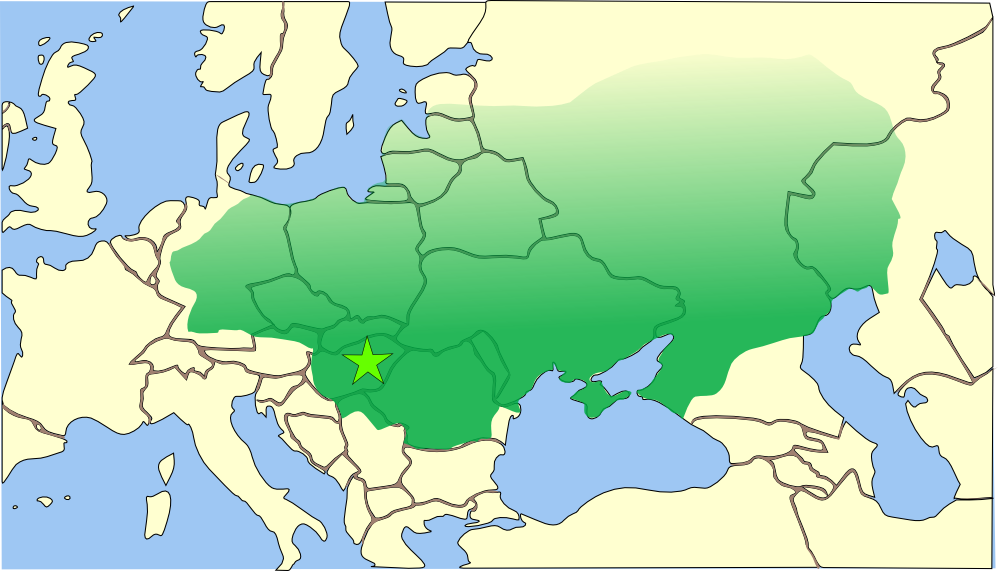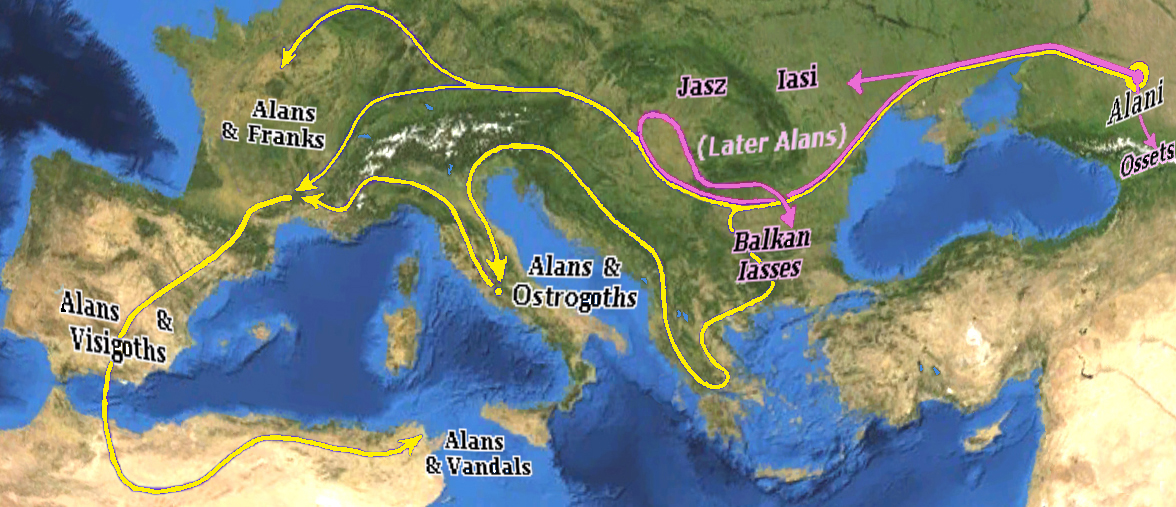|
Thorismund
Thorismund (also Thorismod or Thorismud, as manuscripts of the chief source confusingly attestJordanes, ''De origine actibusque Getarum'' (''Getica'') 81, 174, 190, 201 and elsewhere.) ( 420–453), became king of the Visigoths after his father Theodoric I was killed in the Battle of the Catalaunian Plains (also called Battle of Châlons) in 451 CE. He was murdered in 453 and was succeeded by his brother Theodoric II. Biography Thorismund appears to have played a pivotal role in the Battle of Châlons as he led a contingent of the Visigoth forces in capturing an important summit at the very early stages of the conflict. The summit seems to have extended to the whole of the left flank of the Ostrogoth and Hun forces. Thorismund descended from the hills during the late stages of the conflict, when the Huns had prevailed over the Alans, and the Ostrogoths were pushing the disorganized Visigoths after the death of their king Theodoric. Thorismund led his force of Visigoths in a ... [...More Info...] [...Related Items...] OR: [Wikipedia] [Google] [Baidu] |
Battle Of The Catalaunian Plains
The Battle of the Catalaunian Plains (or Fields), also called the Battle of the Campus Mauriacus, Battle of Châlons, Battle of Troyes or the Battle of Maurica, took place on June 20, 451 AD, between a victorious coalition, led by the Roman general Flavius Aetius and the Visigothic king Theodoric I, against the Huns and their vassals, commanded by their king, Attila. It proved to be one of the last major military operations of the Western Roman Empire, although Germanic '' foederati'' composed the majority of the coalition army. The exact strategic significance is disputed. Historians generally agree that the siege of Aurelianum was the decisive moment in the campaign and stopped the Huns' attempt to advance any further into Roman territory or establish vassals in Roman Gaul. However, the Huns looted and pillaged much of Gaul and crippled the military capacity of the Romans and Visigoths. Attila died only two years later, in 453. After the Battle of Nedao in 454, the coa ... [...More Info...] [...Related Items...] OR: [Wikipedia] [Google] [Baidu] |
Theodoric I
Theodoric I (; ; 390 or 393 – 20 or 24 June 451) was the king of the Visigoths from 418 to 451. Theodoric is famous for his part in stopping Attila the Hun at the Battle of the Catalaunian Plains in 451, where he was killed. Early career In 418 he succeeded King Wallia. The Romans had ordered King Wallia to move his people from Iberia to Gaul. As king, Theodoric completed the settlements of the Visigoths in Gallia Aquitania II, Novempopulana, and Gallia Narbonensis, and then used the declining power of the Roman Empire to extend his territory to the south. After the death of Emperor Honorius and the usurpation of Joannes in 423, internal power struggles broke out in the Roman Empire. Theodoric used this situation and tried to capture the important road junction Arelate, but the magister militum Aëtius, who was assisted by the Huns, was able to save the city. The Visigoths concluded a treaty and were given Gallic noblemen as hostages. The later Emperor Avitus visited Theo ... [...More Info...] [...Related Items...] OR: [Wikipedia] [Google] [Baidu] |
King Of The Visigoths
The Visigothic Kingdom, Visigothic Spain or Kingdom of the Goths () was a barbarian kingdom that occupied what is now southwestern France and the Iberian Peninsula from the 5th to the 8th centuries. One of the Germanic successor states to the Western Roman Empire, it was originally created by the settlement of the Visigoths under King Wallia in the province of Gallia Aquitania in southwest Gaul by the Roman government and then extended by conquest over all of Hispania. The Kingdom maintained independence from the Eastern Roman or Byzantine Empire, whose attempts to re-establish Roman authority in Hispania were only partially successful and short-lived. The Visigoths were romanized central Europeans who had moved west from the Danube Valley. They became foederati of Rome, and sought to restore the Roman order against the hordes of Vandals, Alans and Suebi. The Western Roman Empire fell in 476 AD; therefore, the Visigoths believed they had the right to take the territorie ... [...More Info...] [...Related Items...] OR: [Wikipedia] [Google] [Baidu] |
Theodoric II
Theodoric II ( 426 – early 466) was the eighth King of the Visigoths, from 453 to 466. Biography Theoderic II, son of Theodoric I, obtained the throne by killing his elder brother Thorismund. The English historian Edward Gibbon writes that "he justified this atrocious deed by the design which his predecessor had formed of violating his alliance with the empire." In late 458 the Western Roman Emperor, Majorian entered Septimania to attack Theodoric and reclaim the province for the empire. Majorian defeated Theodoric at the Battle of Arelate, forcing the Visigoths to abandon Septimania and withdraw west to Aquitania. Under the new treaty with the Romans, the Visigoths had to relinquish their recent conquests in Hispania and return to federate status. However, after the assassination of Majorian in 461, Theodoric recaptured Septimania and invaded Hispania again. Theodoric sided with Ricimer and the new emperor Libius Severus against Majorian's magister militum per Gallias Ae ... [...More Info...] [...Related Items...] OR: [Wikipedia] [Google] [Baidu] |
453 Deaths
__NOTOC__ Year 453 ( CDLIII) was a common year starting on Thursday of the Julian calendar. At the time, it was known as the Year of the Consulship of Opilio and Vincomalus (or, less frequently, year 1206 ''Ab urbe condita''). The denomination 453 for this year has been used since the early medieval period, when the Anno Domini calendar era became the prevalent method in Europe for naming years. Events By place Byzantium * July – Empress Pulcheria dies of natural causes at Constantinople. She has commissioned many new churches in the city during her reign. Her death leaves Flavius Aspar (''magister militum'') as the dominant influence on her husband, Marcian. * Anthemius marries Marcia Euphemia, daughter of Marcian, and is elevated to the rank of ''comes''. He is sent to the Danubian frontier to rebuild the border defences. Europe * c. March – Attila the Hun is found dead in bed, after a wedding feast with the Goth princess Ildico. He dies of a noseblee ... [...More Info...] [...Related Items...] OR: [Wikipedia] [Google] [Baidu] |
Balti Dynasty
The Balt dynasty Roger Collins, ''Visigothic Spain, 409–711'' (Blackwell, 2008), p. 45.A. Barbero and M. I. Loring, "The Formation of the Sueve and Visigothic Kingdoms in Spain", in Paul Fouracre (ed.), ''The New Cambridge Medieval History'', Volume 1: c.500–c.700 (Cambridge University Press, 2005), pp. 175 and 178. or Balth dynastyHerwig Wolfram, ''History of the Goths'' (University of California Press, 1979), pp. 32–34, has theories on family connections and Baltic connections. ( or ''Balthi'', i.e., Balts) was the first ruling family of the Visigoths from 395 until 531. They led the Visigoths into the Western Roman Empire in its declining years. According to the historian Ablabius, as reported by the historian Jordanes, the Visigoths had been ruled by the Balti since ancient times. Jordanes, however, says that all the Goths were formerly ruled by the Amal dynasty. Peter Heather, "Balti", in Oiver Nicholson (ed.), ''The Oxford Dictionary of Late Antiquity'' (Oxford Universi ... [...More Info...] [...Related Items...] OR: [Wikipedia] [Google] [Baidu] |
5th-century Murdered Monarchs
The 5th century is the time period from AD 401 (represented by the Roman numerals CDI) through AD 500 (D) in accordance with the Julian calendar. The 5th century is noted for being a period of migration and political instability throughout Eurasia. It saw the collapse of the Western Roman Empire, which came to a formal end in 476 AD. This empire had been ruled by a succession of weak emperors, with the real political might being increasingly concentrated among military leaders. Internal instability allowed a Visigoth army to reach and ransack Rome in 410. Some recovery took place during the following decades, but the Western Empire received another serious blow when a second foreign group, the Vandals, occupied Carthage, capital of an extremely important province in Africa. Attempts to retake the province were interrupted by the invasion of the Huns under Attila. After Attila's defeat, both Eastern and Western empires joined forces for a final assault on Vandal North Africa, but ... [...More Info...] [...Related Items...] OR: [Wikipedia] [Google] [Baidu] |
Gothic Warriors
Gothic or Gothics may refer to: People and languages *Goths or Gothic people, a Germanic people **Gothic language, an extinct East Germanic language spoken by the Goths **Gothic alphabet, an alphabet used to write the Gothic language ** Gothic (Unicode block) * Geats, sometimes called Goths, a large North Germanic tribe who inhabited Götaland Arts and entertainment Genres and styles * Gothic art, a style of medieval art * Gothic architecture, an architectural style * Gothic fiction, a loose literary aesthetic of fear and haunting * Gothic rock, a style of rock music * Goth subculture, developed by fans of gothic rock Gaming * ''Gothic'' (series), a video game series ** ''Gothic'' (video game), 2001 ** Gothic II, 2002 *** Gothic II: Night of the Raven, 2003 ** Gothic 3, 2006 ** ''Gothic'' (upcoming video game), a remake of the 2001 video game Music * Symphony No. 1, or "The Gothic", Havergal Brian * ''Gothic'' (Paradise Lost album), 1991 * ''Gothic'' (Nox Arcana album), ... [...More Info...] [...Related Items...] OR: [Wikipedia] [Google] [Baidu] |
Assassinated Gothic People
Assassination is the willful killing, by a sudden, secret, or planned attack, of a personespecially if prominent or important. It may be prompted by political, ideological, religious, financial, or military motives. Assassinations are ordered by both individuals and organizations, and are carried out by their accomplices. Acts of assassination have been performed since ancient times. A person who carries out an assassination is called an assassin. Etymology ''Assassin'' comes from the Italian and French Assissini, believed to derive from the word ''hashshashin'' (), and shares its etymological roots with ''hashish'' ( or ; from ').''The Assassins: a radical sect in Islam'' – Bernard Lewis, pp. 11–12 It referred to a group of Nizari Ismailis known as the Order of Assassins who worked against various political targets. Founded by Hassan-i Sabbah, the Assassins were active in the Near East from the 11th to the 13th centuries. The group killed members of the Abbasid, ... [...More Info...] [...Related Items...] OR: [Wikipedia] [Google] [Baidu] |
Alans
The Alans () were an ancient and medieval Iranian peoples, Iranic Eurasian nomads, nomadic pastoral people who migrated to what is today North Caucasus – while some continued on to Europe and later North Africa. They are generally regarded as part of the Sarmatians, and possibly related to the Massagetae. Modern historians have connected the Alans with the Central Asian Yancai of China, Chinese sources and with the Aorsi of Ancient Rome, Roman sources. Having migrated westwards and becoming dominant among the Sarmatians on the Pontic–Caspian steppe, the Alans are mentioned by Roman sources in the . At that time they had settled the region north of the Black Sea and frequently raided the Parthian Empire and the South Caucasus provinces of the Roman Empire. From the Goths broke their power on the Pontic Steppe, thereby assimilating a sizeable portion of the associated Alans. Upon the Huns, Hunnic defeat of the Goths on the Pontic Steppe around , many of the Alans migrated w ... [...More Info...] [...Related Items...] OR: [Wikipedia] [Google] [Baidu] |
Edward Gibbon
Edward Gibbon (; 8 May 173716 January 1794) was an English essayist, historian, and politician. His most important work, ''The History of the Decline and Fall of the Roman Empire'', published in six volumes between 1776 and 1789, is known for the quality and irony of its prose, its use of primary sources, and its polemical Criticism of religion, criticism of organized religion. Early life: 1737–1752 Edward Gibbon was born in 1737, the son of Edward Gibbon (died 1770), Edward and Judith Gibbon, at Lime Grove in the town of Putney, Surrey. He had five brothers and one sister, all of whom died in infancy. His grandfather, also named Edward, had lost his assets as a result of the South Sea Company, South Sea bubble stock-market collapse in 1720 but eventually regained much of his wealth. Gibbon's father thus inherited a substantial estate. His paternal grandmother, Catherine Acton, was granddaughter of Sir Walter Acton, 2nd Baronet. Gibbon described himself as "a puny child, neg ... [...More Info...] [...Related Items...] OR: [Wikipedia] [Google] [Baidu] |





